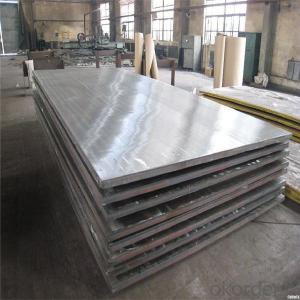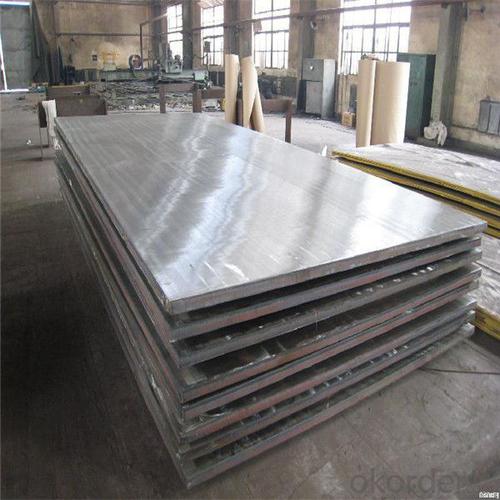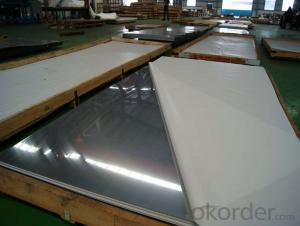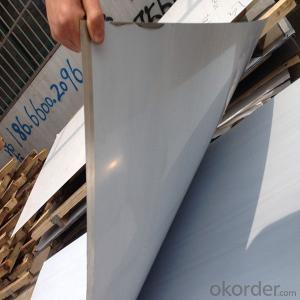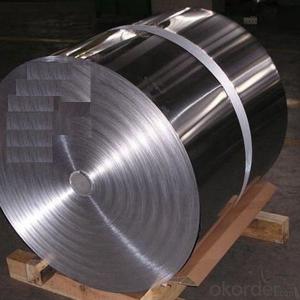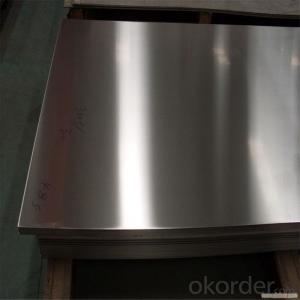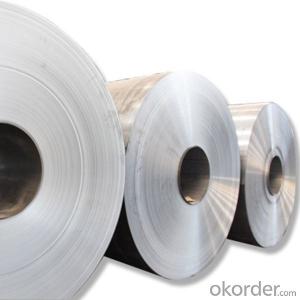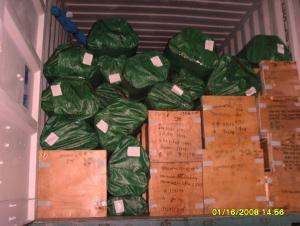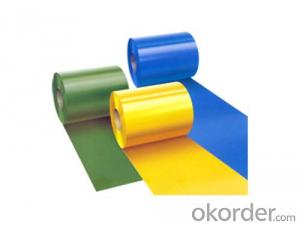TISCO 304L Stainless Steel Sheet from Wuxi, China
- Loading Port:
- Shanghai
- Payment Terms:
- TT OR LC
- Min Order Qty:
- 2 m.t.
- Supply Capability:
- 20000 m.t./month
OKorder Service Pledge
OKorder Financial Service
You Might Also Like
Specification
TISCO 304L stailness steel sheet
Material: 304L
Standard: ASTM, AISI,JIS, DIN,GB
Payment : Usually 30% of the amount by T/T as deposit , and the balance money shall be paid by T/T after got the faxed B/L.Or L/C at sight .
Package: Standard export package ,or based on the customer requirement.
Application: construction.machinebuilding,container manufacturing,shipbuilding,bridges ,etc.
Cold rolled stainless steel sheet
Thickness : | 0.3mm-3.0mm |
Width : | 1000mm/1219mm/1500mm |
Length : | 2000mm/2438mm/4000mm/6000mm or cutting randomly |
Model size : | 0.3mm-3.0mm(TK)*1000mm(W)*2000mm(L) 0.3mm-3.0mm(TK)*1219mm(W)*2438mm(L) 0.3mm-3.0mm(TK)*1500mm(W)*4000mm(L) |
Surface : | 2B, BA, 8K, HL, 2D, Golden 8K, Black 8K etc. |
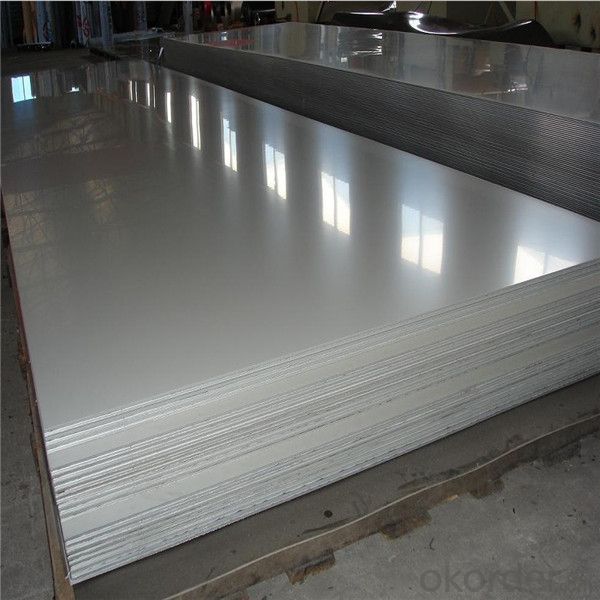
Hot rolled stainless steel sheet
Thickness : | 3.0mm-120mm |
Width : | 1219mm/1500mm/1800mm/2000mm |
Length : | 2000mm/2438mm/4000mm/6000mm or cutting randomly |
Model size : | 3.0mm-120mm(TK)*1219mm(W)*2438mm(L) 3.0mm-120mm(TK )*1500mm(W)*6000mm(L) 3.0mm-120mm(TK) *1800mm(W)*6000mm(L) 3.0mm-120mm(TK) *2000mm(W)*6000mm(L) |
Surface : | Surface : No.1/No.4 |
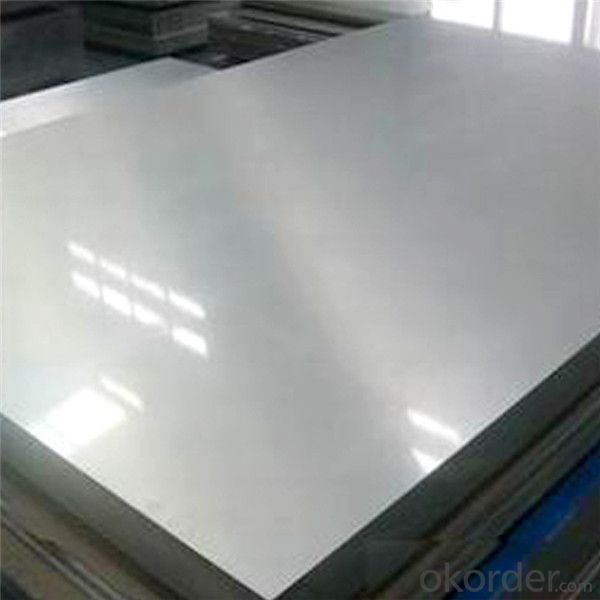
The operating philosophy of our company : high quality and best service and competitive price and prompt delivery .We sincerely welcome the old and new customers to inquiry the price . any questions and needs you have , pls don't hesitate to contact us anytime .
- Q: Are stainless steel sheets suitable for architectural louvers or screens?
- Yes, stainless steel sheets are suitable for architectural louvers or screens due to their durability, corrosion resistance, and aesthetic appeal. They provide a sleek and modern look while also offering protection against weather elements, making them a popular choice for architectural applications.
- Q: Are stainless steel sheets suitable for structural applications?
- Yes, stainless steel sheets are suitable for structural applications. Stainless steel has excellent strength, durability, and corrosion resistance properties, making it a reliable choice for various structural projects. It can withstand high loads and extreme weather conditions, making it suitable for applications such as bridges, buildings, and infrastructure projects.
- Q: Are stainless steel sheets resistant to galvanic corrosion?
- Indeed, galvanic corrosion can be prevented by using stainless steel sheets. When dissimilar metals encounter each other in the presence of an electrolyte like moisture or saltwater, galvanic corrosion ensues. The process involves one metal acting as an anode and the other as a cathode, resulting in the transfer of electrons and corrosion of the anode. Stainless steel, an alloy that incorporates chromium, possesses a passive oxide layer on its surface. This layer serves as a protective shield, impeding the transfer of electrons and effectively combatting galvanic corrosion. The chromium in stainless steel reacts with oxygen in the atmosphere, generating a thin, invisible, and self-rejuvenating layer of chromium oxide. This exceptional layer provides outstanding corrosion resistance, rendering stainless steel highly resistant to galvanic corrosion when combined with other metals. Nevertheless, it is worth noting that the level of corrosion resistance can vary depending on the specific grade and composition of stainless steel employed. Some stainless steel alloys, such as Type 316 stainless steel, offer even greater resistance to galvanic corrosion due to the inclusion of molybdenum, which bolsters its corrosion resistance in aggressive environments. In conclusion, stainless steel sheets typically exhibit remarkable resistance to galvanic corrosion due to the presence of a passive chromium oxide layer on their surface. This makes stainless steel an excellent choice for applications where galvanic corrosion poses a concern, such as marine environments or when in contact with dissimilar metals.
- Q: Can stainless steel sheets be used in the construction industry?
- Yes, the construction industry can utilize stainless steel sheets. Stainless steel is a versatile material that offers various advantages, making it suitable for diverse construction applications. One of the primary benefits of stainless steel sheets is their exceptional resistance to corrosion. They possess a high resistance to rust and staining, making them perfect for outdoor structures or areas exposed to high levels of moisture or chemicals. This durability ensures a longer lifespan and reduces maintenance costs for construction projects. Moreover, stainless steel sheets are renowned for their strength and toughness. They have a high tensile strength, enabling them to withstand heavy loads and impacts. This renders them appropriate for structural components like beams, columns, and support systems. Additionally, stainless steel sheets provide aesthetic appeal due to their sleek and shiny appearance. They can be easily manipulated and formed into various shapes, allowing for creative and visually pleasing architectural designs. Stainless steel is commonly used in cladding, roofing, and decorative elements in contemporary buildings. Apart from their physical properties, stainless steel sheets are also environmentally friendly. They are 100% recyclable, which minimizes waste and conserves resources. This makes them a sustainable choice for construction projects aiming for green building certifications. All in all, stainless steel sheets are a dependable and versatile material that can be utilized in a wide range of construction applications. Their corrosion resistance, strength, aesthetics, and environmental sustainability make them a popular option in the construction industry.
- Q: How do you prevent scratching on stainless steel sheets during handling and installation?
- To avoid scratching stainless steel sheets while handling and installing them, there are several precautions you can take: 1. Apply protective covering: Prior to handling or installation, it is advisable to apply a protective film or covering on the surface of the stainless steel sheets. This covering acts as a barrier, safeguarding against scratches and scuff marks during transportation and installation. It is important to ensure that the chosen covering is suitable for stainless steel and leaves no residue when removed. 2. Handle with caution: It is crucial to be mindful of how you handle the stainless steel sheets. Avoid dragging or sliding them against rough surfaces or each other, as this can result in scratches. Instead, use appropriate lifting techniques and handle the sheets with clean, dry hands or gloves to minimize the risk of leaving marks. 3. Utilize suitable tools: When working with stainless steel sheets, ensure that you use tools specifically designed for this purpose. Refrain from using tools with rough or abrasive surfaces that could potentially scratch the stainless steel. Opt for tools made from soft materials or those with protective coatings to reduce the chances of surface damage. 4. Keep work areas clean: Before installing stainless steel sheets, it is essential to ensure that the work area is clean and free from any debris or particles that could potentially scratch the surface. Use a clean cloth or soft brush to wipe down the area, removing any dirt, dust, or loose materials that could cause scratches during the installation process. 5. Secure sheets during transportation: If you need to transport stainless steel sheets, it is crucial to secure them properly to prevent any movement or shifting that could lead to scratches. Utilize appropriate packaging materials such as foam inserts, edge protectors, or straps to keep the sheets in place and minimize the risk of damage. By adhering to these preventive measures, you can significantly reduce the likelihood of scratching stainless steel sheets during handling and installation, ensuring a flawless finish and preserving the quality of the material.
- Q: What are the benefits of using diamond plate stainless steel sheets?
- Using diamond plate stainless steel sheets offers numerous advantages. Firstly, these sheets are highly durable and resistant to corrosion. Stainless steel is well-known for its strength and ability to withstand harsh environments, making it an ideal option for various uses. The diamond plate pattern further enhances the sheets' durability, providing additional strength and traction. Secondly, diamond plate stainless steel sheets possess a distinctive aesthetic appeal. The diamond pattern not only adds a visually pleasing texture but also helps conceal scratches and dents, resulting in cleaner and more pristine sheets. Consequently, they are a popular choice for architectural and decorative purposes. Moreover, diamond plate stainless steel sheets are effortless to clean and maintain. The smooth stainless steel surface allows for easy cleaning, while the diamond pattern reduces the visibility of dirt and grime. This makes them suitable for environments requiring frequent cleaning, such as commercial kitchens or industrial facilities. Furthermore, these sheets offer exceptional slip resistance. The raised diamond pattern provides traction, minimizing the risk of slips and falls. Consequently, they are particularly valuable in areas prioritizing safety, such as ramps, stairs, or walkways. Overall, diamond plate stainless steel sheets provide durability, corrosion resistance, aesthetic appeal, easy maintenance, and slip resistance. These qualities make them a versatile option for a wide range of applications, including industrial settings and architectural designs.
- Q: Can stainless steel sheets be used for cladding?
- Indeed, cladding can utilize stainless steel sheets. The preference for stainless steel as a cladding material stems from its robustness, ability to withstand corrosion, and visual allure. It is frequently employed in the external cladding of structures, including facades, canopies, and curtain walls. Stainless steel sheets provide an elegant and contemporary look while furnishing defense against severe environmental circumstances. Furthermore, stainless steel cladding necessitates minimal upkeep, boasts an extended lifespan, and can be effortlessly cleaned, rendering it a pragmatic selection for both residential and commercial purposes.
- Q: Are stainless steel sheets suitable for architectural wire mesh?
- Yes, stainless steel sheets are highly suitable for architectural wire mesh. Stainless steel is a popular choice for architectural applications due to its numerous advantageous properties. Firstly, stainless steel is exceptionally durable and resistant to corrosion, making it ideal for long-term use in both indoor and outdoor environments. This resistance to corrosion is particularly important for architectural wire mesh, as it ensures the material will maintain its integrity and appearance over time. Additionally, stainless steel sheets offer excellent strength and stability, enabling them to withstand the various stresses and strains that architectural wire mesh may encounter. This is crucial in applications where the mesh needs to support structural loads or provide security. Moreover, stainless steel is available in different grades, with varying levels of strength and flexibility, allowing for customization to meet specific project requirements. Another significant advantage of stainless steel sheets is their aesthetic appeal. The sleek and modern appearance of stainless steel complements contemporary architectural designs and adds a touch of elegance to any space. Furthermore, stainless steel can be finished in different ways, such as brushed, polished, or coated, to achieve the desired visual effect. Lastly, stainless steel is a sustainable material choice for architectural wire mesh. It is 100% recyclable, reducing environmental impact and supporting green building initiatives. Additionally, stainless steel's long lifespan and low maintenance requirements contribute to its sustainability, as it minimizes the need for frequent replacements or repairs. In conclusion, stainless steel sheets are highly suitable for architectural wire mesh due to their durability, corrosion resistance, strength, aesthetic appeal, and sustainability. Their versatility and ability to meet various project requirements make them a preferred material for architects and designers in creating visually stunning and functional wire mesh installations.
- Q: What are the different types of etched patterns available for stainless steel sheets?
- There are several different types of etched patterns available for stainless steel sheets, each offering a unique and visually appealing design. Some of the popular etched patterns include: 1. Diamond Pattern: This pattern features a series of small diamond-shaped indentations etched onto the surface of the stainless steel. It creates a classic and elegant look, often used in architectural applications. 2. Checkerboard Pattern: As the name suggests, this pattern resembles a checkered board, with alternating squares etched onto the stainless steel sheet. It offers a modern and geometric design, commonly used in interior design and decorative applications. 3. Floral Pattern: This pattern incorporates various floral designs etched onto the stainless steel sheet. It adds a touch of elegance and sophistication, often seen in luxury home decor and jewelry. 4. Geometric Pattern: Geometric patterns include a wide range of designs, such as circles, squares, triangles, and other abstract shapes etched onto the stainless steel sheet. These patterns offer a contemporary and artistic look, suitable for both modern and traditional settings. 5. Wave Pattern: This pattern features wavy lines etched onto the stainless steel sheet, creating a sense of movement and fluidity. It is commonly used in architectural projects, giving a dynamic and visually interesting effect. 6. Textured Pattern: Textured patterns involve various textures etched onto the stainless steel sheet, such as brushed, hammered, or linen finishes. These patterns add depth and dimension to the metal, making it ideal for interior design and decorative purposes. 7. Custom Patterns: In addition to the standard etched patterns, there is also the option to create custom patterns based on specific designs or logos. This allows for personalized and unique stainless steel sheets, often used in branding or specialty projects. Overall, the variety of etched patterns available for stainless steel sheets allows for endless possibilities in design and application. Whether it's for architectural, decorative, or industrial purposes, there is a pattern to suit every need and aesthetic preference.
- Q: Can stainless steel sheets be used for electrical or electronic applications?
- Yes, stainless steel sheets can be used for electrical or electronic applications. Stainless steel has excellent electrical conductivity and is resistant to corrosion, making it an ideal material for various electrical components. It is commonly used in electrical enclosures, switchgear, control panels, and other electrical equipment. Additionally, stainless steel sheets can be fabricated into different shapes and sizes, making them suitable for various electronic applications such as printed circuit boards (PCBs), connectors, and terminals. The durability and high temperature resistance of stainless steel also make it a preferred choice for electrical and electronic applications in harsh environments.
Send your message to us
TISCO 304L Stainless Steel Sheet from Wuxi, China
- Loading Port:
- Shanghai
- Payment Terms:
- TT OR LC
- Min Order Qty:
- 2 m.t.
- Supply Capability:
- 20000 m.t./month
OKorder Service Pledge
OKorder Financial Service
Similar products
Hot products
Hot Searches
Related keywords
